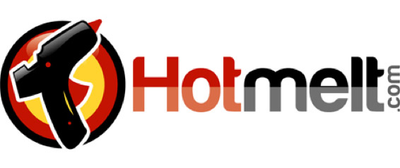Wood glue isn’t always the best choice for joining wood to wood. In some applications a PUR adhesive might be a better choice. Understanding the reasons for this requires a closer look at the chemistry of these adhesives and the process by which they form bonds. Once equipped with this knowledge the pros and cons of each will become clear.
Basics of Wood Glue
Adhesives described as “wood glue” are usually water-based formulations of polyvinyl acetate, PVA for short. This comes as white or yellow liquid that’s applied to the surfaces being joined.
It’s the water content that helps PVA adhesives form bonds with porous materials. The water penetrates the surface and then dries, leaving the glue to hold the joint together. When bonding wood with a PVA adhesive it’s essential the pieces are clamped together until the water has dried. Any attempt to reposition them will weaken and even break the bond before it’s fully formed.
Less often, EVA holt melt adhesives are sometimes used for gluing wood. These work in a similar way to PVA adhesives, but use a solvent rather than a water base. Check out our guide to EVA adhesives for more information.
Basics of PUR Adhesives
Like PVA adhesives, and unlike epoxies, polyurethane reactive (PUR) adhesives are one part adhesives. That is, they don’t require mixing before application. However, PUR adhesives have a very different method of bonding.
Used as a hot melt, PUR is applied to a porous surface like wood as a liquid. There, solidification forms the initial bond, after which the PUR adhesive starts to react with moisture. This process, which takes 24 – 48 hours to complete, expands the adhesive slightly to form a strong bond between the surfaces.
Readers who want to learn more about this family of adhesives should take a look at our complete guide to PUR adhesives.
Pros and Cons of PVA Wood Glues
PVAs work well with wood because it’s a porous material. This ensures good penetration that leads to a strong bond. In addition, it has no odor and is clear when it dries. For industrial-scale applications the PVA formulation can be tailored to provide the required open time, (the time after application for which the adhesive remains active,) and set time, (the time needed to form a bond.) However, it also has some limitations. These are:
- Parts require clamping in position while the adhesive dries
- PVA retains a degree of flexibility and can break apart so should be considered a complement to other fasteners
- Not readily sanded and doesn’t take stain well
- Doesn’t necessarily seal a joint against moisture
- Water solubility limits use in wet or damp conditions
- Will soften in high temperatures (160°F (77°C) and higher.)
Pros and Cons of PUR For Joining Wood
For PUR its strength – an eagerness to react with moisture – is also a weakness as it means PUR has a finite shelf life. However, there’s more to this adhesive than that. When choosing a wood glue, consider first these advantages of PUR adhesives:
- Creates extremely strong bonds that don’t need supplementing with other fasteners
- Short set time (as short as 15 seconds, depending on formulation,) so minimal clamping-in-place required
- No VOC/solvent emissions
- Expansion fills voids and creates a watertight seal
- Can be sanded and accepts a stain
- Bond strength is retained at temperatures up to 300⁰F (150⁰C)
- Effectiveness is not reduced by moisture
Points to be aware of regarding PUR adhesives are:
- Shelf life is around 12 months
- Exposure to air starts the curing reaction
- Can’t be cleaned up with water – requires a solvent instead
How Adhesive Characteristics Affect Applications in Woodworking
PVA wood glues can yield acceptable results where the joint is held firmly in place through the curing process. In this regard it complements other fasteners. Where it struggles is in applications where there is no other clamping. Edge bonding is perhaps the most obvious example.
It’s also useful where post-joining cleanup may be required as visible excess can be wiped away readily.
PUR is especially useful where it is the sole bonding mechanism. This makes it valuable in structural applications. It’s also good for edge bonding, with the limitation that tight control over the volume of adhesive dispensed is important to minimize any cleanup.
A further advantage of PUR in edge bonding is that it seals the joint against water ingress.
Tailoring Formulations for the Task
The companies that manufacture PUR adhesives tailor properties like viscosity, open time and set time to suit particular requirements and types of application. Accordingly, there are a wide range of PUR adhesive products in various formats and with different options for dispensing.
Our application specialists can help you choose the best products for your operation. Contact us for advice on PUR adhesives or for help with testing PUR adhesives for your application.
Related Products: Infinity Bond Flex 50 PUR Hot Melt Applicator

